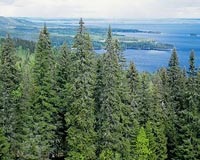| . |  |
. |
Barcelona, Spain (SPX) Mar 30, 2010 Ecosystems are essential for preserving the quality of life of human beings, and society should be aware of this, according to Ms Miren Onaindia, biologist and person responsible for the Forest Ecology and Natural Resources research team at the University of the Basque Country (UPV/EHU). This group has been investigating the woods and forest of the Autonomous Community of the Basque Country (CAV-EAE) for twenty years now. In recent times they have focused on evaluating the situation of ecosystems, concentrating on biodiversity. "If trees are healthy then the mountains are protected. The soil maintains itself in a good state and this protects from erosion, in case of floods". With this simple example, Ms Onaindia explained why it is so important that society as a whole maintains ecosystems in an optimum state. Ms Onaindia and six other members of the Department of Plant Biology and Ecology make up this working group devoted to examining forests, currently focused on evaluating the ecosystems of the CAV-EAE. With this goal, they analyse plants indicative of the biodiversity and the internal structure in each forest investigated. "Some species have the ability to indicate that a forest is in a good state and other, on the other hand, that the woodland is degrading", explained Ms Onaindia. Cartography has also been of great use in the study. The GIS (Geographical Information System) programme enabled them to examine the terrain in a global manner, thus obtaining information about, for example, how the cover of the plants and the size of the ecosystems are like or the relation between them. With the gathered data and applying a number of formulae, they evaluated the situation of the forest ecosystem, thanks to the calculation of the species existing and the proportions in which they were found. According to Ms Onaindia, one of the objectives of the research group is to obtain results that can be useful in forestry management, i.e. the research work be "applicable". For example, in the case of pinewoods, they came to conclusions that merit practical application. Pine trees are in terrain previously occupied by autochthonous species in the forests of the CAV-EAE. Nevertheless, as this group has observed, pine trees have the ability to recover autochthonous woods that are in a degraded state (oakwoods, for example), whenever the management is the appropriate one. "Pine trees help forests to stabilise. They can act to recover an ecosystem if they are subsequently extracted at the appropriate moment, given that oakwoods can grow under the canopy cover of the pines", explained Ms Ibone Amezaga, lecturer and member of the research group.
An exemplary oakwood in Arratzu The research team has observed that, in those few places in the CAV-EAE where there are oakwoods, the indicators for biodiversity are especially high. "In Arratzu we can find a large oakwood that is a model to follow: many species are found there; species that show great maturity. The functions of the ecosystem are very well met with in this oak wood", stated Ms Onaindia.
A European investigation, in Bizkaia This research, being undertaken in collaboration with the Bizkaia Provincial Government, examines the importance of biodiversity and the services provided by ecosystems from both the scientific perspective and the social. It is being carried out in the Greater Bilbao metropolitan area, in the Urdaibai estuary, in the Lea region and in the (highland) Urkiola. "On the one hand, we want to see what are the most important services provided by ecosystems for people", explained Ms Onaindia. As a result of this, 400 residents of Greater Bilbao were interviewed personally. "On the other hand, through our research, we wished to clarify what were the most outstanding ecosystems in these zones - in order to protect them. This information will be highly useful for a Manager when a decision has to be made where and how to build something". This research falls within the remit of the European global Millennium Ecosystem Assessment and in which various research teams are undertaking similar studies with similar methodologies. Ms Onaindia's group has used the same methodology applied to these four zones of the Basque province of Bizkaia.
Share This Article With Planet Earth
Related Links University of the Basque Country Forestry News - Global and Local News, Science and Application
 Map Of Boreal Forest Biomass Produced From Radar Satellite Data
Map Of Boreal Forest Biomass Produced From Radar Satellite DataParis, France (SPX) Mar 29, 2010 Having a large-scale boreal forest biomass inventory would allow scientists to understand better the carbon cycle and to predict more accurately Earth's future climate. However, obtaining these maps has been wrought with difficulty - until now. A new processing algorithm has been developed using stacks of images from the Advanced Synthetic Aperture Radar (ASAR) on ESA's Envisat satellite t ... read more |
|
| The content herein, unless otherwise known to be public domain, are Copyright 1995-2010 - SpaceDaily. AFP and UPI Wire Stories are copyright Agence France-Presse and United Press International. ESA Portal Reports are copyright European Space Agency. All NASA sourced material is public domain. Additional copyrights may apply in whole or part to other bona fide parties. Advertising does not imply endorsement,agreement or approval of any opinions, statements or information provided by SpaceDaily on any Web page published or hosted by SpaceDaily. Privacy Statement |